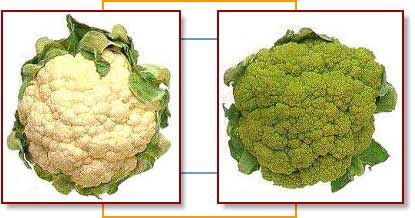
Cauliflower, as its name implies, is a flower growing from a plant. In its
early stages, it resembles broccoli, which is its closest relative. While
broccoli opens outward to sprout bunches of green florets, cauliflower
forms a compact head of undeveloped white flower buds. The heavy green
leaves that surround the head protect the flower buds from the sunlight.
The lack of exposure to sunlight does not allow chlorophyll to develop.
Therefore, color is not produced, and the head remains a white color.
Cauliflower is an excellent source of Vitamin C.
Cauliflower is generally available year round, but it is usually more
plentiful in autumn. When selecting cauliflower, look for heads that are
white or creamy white, firm, compact, and heavy for their size. There
should not be any speckling of discoloration on the head or leaves. Avoid
cauliflower with brown patches. A medium-size head, that is 6 inches in
diameter and weighs about 2 pounds, will serve 4 to 6 people.
Cauliflower will keep for up to five days if stored in the crisper
section of the refrigerator. If the head is not purchased wrapped, store
it in an open or perforated plastic bag. Keep the head stem-side up to
prevent moisture form collecting on it. For the best flavor, cauliflower
should be eaten as soon as possible. Precut florets do not keep well, and
they are best when eaten within a day of purchase.
There are two types of cauliflower on the market today. The creamy
white florets are more abundant in the United States but some markets sell
a recently developed cauliflower-broccoli hybrid. This type of cauliflower
has a green curd and resembles broccoli. The green variety is less dense
than the white, cooks more quickly, and has a milder taste.
 |
|
Cauliflower |
Broccoflower |
Cauliflower can be served cooked or raw. Peel off stem leaves. Turn
cauliflower upside down. Cut the stem just above where the florets join
together. Separate the florets into equal sized pieces. Cut if necessary.
When cooking cauliflower, you may leave the head whole. Rapid cooking
time not only reduces the odorous sulfur compounds but also preserves
crispness, color, and reduces the loss of nutrients that will leach into
the cooking water when vegetables are overcooked. Steaming and microwaving
cauliflower will better preserve its vitamin content, especially the B
vitamins, than if it is boiled. To microwave cauliflower, put 2 cups of
florets in a shallow microwavable dish, or cover a whole head of
cauliflower with plastic wrap. For florets, cook for 3 minutes on high,
then let stand for 2 minutes. For whole cauliflower, cook on high for 3
minutes, turn head over, and cook for an additional 2 to 4 minutes. Let
stand for 3 minutes. To steam cauliflower, place it in a steamer basket,
and then place in a pot with 2 inches of water. Cover and steam. Florets
will take 3 to 5 minutes to cook. A whole head of cauliflower (1 ½
pounds) will take 15 to 20 minutes to cook, but begin checking for
tenderness after 12 minutes.
Tip
Cauliflower may turn yellow in alkaline water. For whiter
cauliflower, add a tablespoon of milk or lemon juice to the water.
Do not cook cauliflower in an aluminum or iron pot. The chemical
compounds in cauliflower will react with the aluminum and turn the
vegetable yellow. While in an iron pot, it will turn a brown or
blue-green color.
| |
|
Cooked Cauliflower |
Serving Size
1/2 cup (62g)
|
Amount Per Serving |
% Daily Value |
|
Calories 15 |
|
|
Calories from Fat 5 |
|
| Total Fat 0 |
0% |
|
Saturated Fat 0g |
0% |
| Cholesterol
0mg |
0% |
| Sodium 10mg |
0% |
| Total
Carbohydrate 3g |
1% |
| Dietary
Fiber 2g |
8% |
| Sugars
1g |
|
| Protein 1g |
|
| Vitamin
A |
0% |
| Vitamin C |
45% |
| Calcium |
0% |
| Iron |
2% |
*Percent Daily Values are based on a
2,000 calorie diet.
|
|
| |
|
|
| |
| Raw Cauliflower |
Serving Size
1/2 cup (50g)
|
Amount Per Serving |
% Daily Value |
|
Calories 15 |
|
| Calories from Fat 0
|
|
| Total Fat 0 |
0% |
|
Saturated Fat 0g |
0% |
| Cholesterol
0mg |
0% |
| Sodium 15mg |
1% |
| Total
Carbohydrate 3g |
1% |
| Dietary
Fiber 1g |
4% |
| Sugars
1g |
|
| Protein 1g |
|
| Vitamin
A |
0% |
| Vitamin C |
40% |
| Calcium |
2% |
| Iron |
2% |
*Percent Daily Values are based on a
2,000 calorie diet.
|
|
| |
|
|
Recipes
Cauliflower with Paprika-Garlic Sauce
Makes 4 servings.
Ingredients
4 cups small cauliflower florets
2 gloves garlic, minced
1 tsp olive oil
2 Tbsp apple juice
1 Tbsp snipped fresh parsley
1 Tbsp red wine vinegar
1½ tsp paprika
1/8 tsp salt
In a large saucepan with steamer rack, steam cauliflower over boiling
water covered for about 8 minutes or until crisp-tender. Meanwhile, using
a small saucepan prepare sauce. First cook garlic in hot oil for 30
seconds. Remove from heat; stir in apple juice, parsley, vinegar, paprika,
and salt. Cook sauce until heated. Transfer cauliflower to a serving dish.
Pour sauce over the hot cauliflower. Toss to coat.
Nutritional analysis per serving: Calories 44, Total Fat 1g, Saturated Fat
0g, Carbohydrates 8g, Protein 2g, Cholesterol 0mg, Fiber 3g, Sodium 104mg, Carbohydrates
58%, Protein 17%, Fat: 25%.
Find more in our
recipe database!
|



